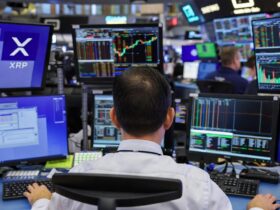Uncertainty continues to set the pace of financial markets. Are we entering a crisis or, on the contrary, is a recovery coming?
While some analysts are optimistic and believe that the worst is over, others maintain a much more pessimistic stance, warning that the worst could be yet to come.
In this landscape of conflicting opinions, one thing is certain: investors are not waiting for the horizon to clear. Decisions are already being made, and one of the most affected assets has been the United States Treasury bond, which is often called “the safest investment in the world.” In words from Bloomberg specialists, “Traders hit the pause button on Treasuries”.
A recent report from the Department of Labor showed a fall in initial claims for unemployment benefits at 218,000 for the week ending September 21 (down 4,000 from the previous week and the lowest level since mid-May). This brought some relief to the economy, in general.
As a consequence, markets are increasingly focused on the possibility of the Fed cutting interest rates again at its November meeting, which could make bonds even more unattractive.
Although jobs data was positive, bets on a rate cut have continued to rise. It is speculated that The Federal Reserve could opt for a reduction of between 25 and 50 basis pointswhich would keep pressure on Treasury bond yields, further diminishing their attractiveness as an investment.
Stocks, gold and bitcoin benefit from low Treasury yields
When the Federal Reserve cuts interest rates, Treasury bond yields fall. As investors anticipate these cuts, many are pulling their money out of Treasury bonds to look for better returns in other areas.
The yield on the 10-year bond has fallen slightly, settling at 3.78%. However, if the Fed presses ahead with a more aggressive tapering policy, yields could fall further, making these debt instruments less attractive compared to more volatile assets, including stocks, gold and bitcoin (BTC).
Traditionally considered a safe haven, gold tends to appreciate when interest rates fall. Meanwhile, stocks tend to attract more capital in these scenarios, since companies benefit from lower financing costs and investors—as already explained—seek higher returns in equity markets.
For its part, bitcoin has shown a growing correlation with these assets. In an environment of lower interest rates and reduced bond yields, bitcoin is positioned as an attractive alternative.
Bitcoin has its own reasons to rise
The price of bitcoin does not depend on Treasury bonds and interest rates alone. There are others fundamental factors that suggest a bullish scenario for this digital currency in the remainder of 2024 and, perhaps, much of 2025.
One of the main catalysts is the bitcoin halvingwhich happened six months ago. This block reward halving has historically been a turning point for bitcoin bull cycles. After each halving, the supply of new bitcoins entering the market decreases, causing upward pressure on the price due to lower supply and increasing demand. If we review previous cycles, such as 2016 or 2020, each halving marked the beginning of a price rally that attracted thousands of new investors, and expectations for this cycle are no different. Historically, the great bullish cycle begins about six months after the halving, which would occur this October.
Furthermore, this cycle is different because the Spot bitcoin ETF in the United States (main financial power worldwide) are already a reality, as reported by CriptoNoticias in January 2024. The launch of these exchange-traded funds makes it easier for large institutional investors, such as pension funds and large asset managers, to have access to bitcoin without the need to directly purchase the digital currency.
On the other hand, companies like MicroStrategy are also taking significant steps in corporate adoption of bitcoin as a store of value. The company, led by Michael Saylor, already has more than 250,000 BTC on its balance sheet, becoming one of the most visible examples of how companies are beginning to treat bitcoin as a long-term strategic asset.

MicroStrategy is not the only one; Other large companies, such as Tesla, have experimented with holding bitcoin on their balance sheets, strengthening the perception that bitcoin is an effective hedge against inflation and dollar fluctuations.
The following graph, taken from the BitcoinTreasuries platform, shows the 20 publicly traded companies with the largest amount of BTC in their treasuries, worldwide:

In terms of supply and demand, the entry of new entrants into the market, whether through ETFs or growing enterprise and individual adoption, is colliding with a maximum supply of 21 million bitcoin. As demand increases, the inherent scarcity of bitcoin will increase competition to acquire it, which has historically driven its price steadily up.
Finally, it cannot fail to be mentioned that at the beginning of November the presidential elections in the United States will take place. Both Donald Trump and Kamala Harris, the two main candidates, have spoken favorably about the bitcoin industry, cryptocurrencies and “the blockchains.” If their promises are genuine and, upon coming to power, they act in a way that encourages investment and industry growth, then the price of bitcoin will have another driver that will take it to new heights.






Leave a Reply